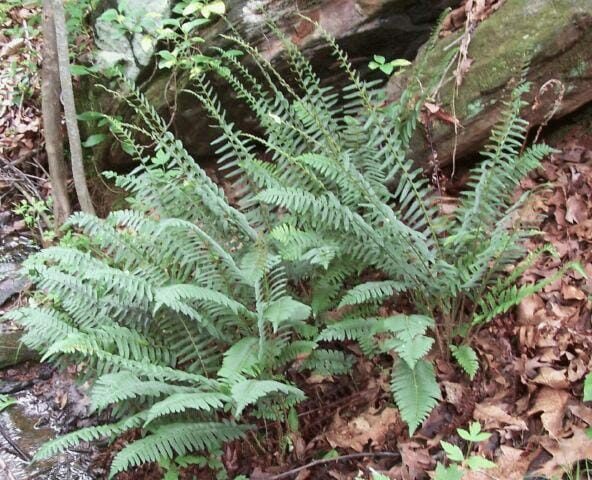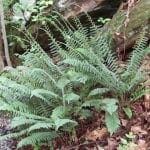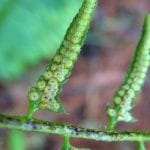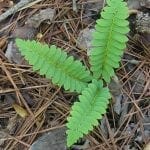- Habit
- Sori (spore cases)
- Young fern
- Fiddlehead
The Georgia Native Plant Society is pleased to announce that its members have selected Christmas fern (Polystichum acrostichoides) as the Society’s 2008 Plant of the Year.
Christmas fern is among the most common ferns in the Southeast, and its evergreen fronds provide four seasons of interest and grace woods and shady hillsides throughout the state of Georgia. It is equally attractive in the garden, where it is effective as a tall ground cover or as a companion to other shade-loving ferns, perennials, and wildflowers.
Although Christmas fern prefers moist, well-drained soil, it is remarkably drought tolerant, making it one of our most adaptable and dependable native ferns. It is most often found in partial to full shade but will tolerate a fair amount of sun if adequate moisture is provided. In the wild it is found in a wide range of soil types and conditions, making it an accommodating and low-maintenance garden plant. Gardeners will also be delighted to know that Christmas fern is rarely browsed by deer.
This tough and easy-to-transplant fern is a stalwart performer for the GNPS Restoration Program. Hundreds of rescued Christmas ferns have been relocated to both the Piedmont Park and Grant Park restoration sites. Restoration Committee co-chairman Veronica Hawk notes that these plants are especially valuable on sites that need erosion control: “If you are in the woods, take a look at the creeks and riverbanks. In a natural environment, this fern is always the steadfast plant of the bank, holding on to topsoil, allowing other plants to germinate and continue to protect stream banks. They are hardy plants, they are evergreen, and they adapt well to moist or dry conditions. You can’t ask for more.”
Christmas fern’s tightly coiled fiddleheads emerge silvery green in early spring. As the frond matures, the long, narrow blade deepens to a rich, dark green. The stipe (stalk or petiole) of the frond is brown and scaly at the base. The blade (leafy portion) of the frond is lanceolate and widest at the base. The blade is pinnate, meaning that it is divided into a number of pinnae (leaflets) that are arranged regularly on each side and the pinnae are cut all the way to the rachis (axis of the blade).
On mature plants, the first fronds that emerge in spring are generally fertile and are held stiffly upright. The sori (spore cases) are round and appear on the upper third to half of the fertile frond. They are arranged in rows on each side of the pinna midrib. This characteristic gives Christmas fern its botanical name, for in Greek, poly means “many” and stichos means “row.” The fertile fronds are followed by somewhat shorter, sterile fronds, which tend to be more loosely arching in form.
Opinions differ regarding the origin of Christmas fern’s common name. Some state that it comes from the fact that the fern is evergreen at Christmas and was used by early settlers as holiday decoration. Others believe it comes from the fact that the pinnae, especially the larger ones, are shaped like a Christmas stocking or like Santa’s sleigh or boot.
Plants are typically 18 to 30 inches tall and spread by a creeping rhizome to a similar width. Dense clumps are easily divided, preferably in spring or fall. Under the right conditions, Christmas fern will naturalize by spores, gently expanding its presence in the garden.
Prepared by Mary Pyne Tucker for the Georgia Native Plant Society
Scientific Name:
Common Name:
Scientific Name Pronounciation:
Plant Type:
Fern
Plant Hardiness Zones:
Plant Hardiness Zone(s):
Usual Size:
Flower:
Bloom Time Notes:
Leaf:
Fruit:
Wildlife:
Natural Habitat:
Propagation:
Bloom Time:
Sun or Shade:
Companion Plants:
Cultural Notes:





